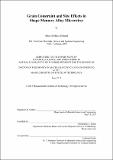| dc.contributor.advisor | Christopher A. Schuh. | en_US |
| dc.contributor.author | Ueland, Stian Melhus | en_US |
| dc.contributor.other | Massachusetts Institute of Technology. Department of Materials Science and Engineering. | en_US |
| dc.date.accessioned | 2013-09-24T18:22:12Z | |
| dc.date.available | 2013-09-24T18:22:12Z | |
| dc.date.copyright | 2013 | en_US |
| dc.date.issued | 2013 | en_US |
| dc.identifier.uri | http://hdl.handle.net/1721.1/80893 | |
| dc.description | Thesis (Ph. D.)--Massachusetts Institute of Technology, Dept. of Materials Science and Engineering, 2013. | en_US |
| dc.description | This electronic version was submitted by the student author. The certified thesis is available in the Institute Archives and Special Collections. | en_US |
| dc.description | Cataloged from student-submitted PDF version of thesis. | en_US |
| dc.description | Includes bibliographical references (p. 142-147). | en_US |
| dc.description.abstract | Shape memory alloys exhibit interesting and useful properties, such as the shape memory effect and superelasticity. Among the many alloy families that have been shown to exhibit shape memory properties the ones based on copper are interesting because they are relatively inexpensive and show excellent properties when made as single crystals. However, the performance of these alloys is severely compromised by the introduction of grain boundaries, to the point where they are too poor for commercial applications. This thesis studies the mechanical properties of fine Cubased wires with a bamboo microstructure, i.e., where triple junctions are absent and grain boundaries run perpendicular to the wire axis. These microwires are not single crystals, but their microstructure is not as complex as that of polycrystals either: we call this new class of shape memory alloys oligocrystals. This thesis seeks to better understand the relationship between microstructure and properties in these alloys through a combination of mechanical testing, in situ experiments and modeling. First, in situ scanning electron microscopy, together with finite element modeling, is used to understand the role of grain constraint on the martensitic transformation. Grain constraints are observed to be much less severe in oligocrystalline wires as compared to polycrystals. Oligocrystalline microwires are then thermomechanically tested and shown to exhibit excellent properties that approach those of single crystals. Next, property evolution during cycling is investigated, revealing training effects as well as fatigue life and fracture. Finally, size effects in damping and transformation morphology are studied and it is shown that a transition from a many-domain to a single domain martensite morphology takes place when the wire diameter is decreased. | en_US |
| dc.description.statementofresponsibility | by Stian Melhus Ueland. | en_US |
| dc.format.extent | 147 p. | en_US |
| dc.language.iso | eng | en_US |
| dc.publisher | Massachusetts Institute of Technology | en_US |
| dc.rights | M.I.T. theses are protected by
copyright. They may be viewed from this source for any purpose, but
reproduction or distribution in any format is prohibited without written
permission. See provided URL for inquiries about permission. | en_US |
| dc.rights.uri | http://dspace.mit.edu/handle/1721.1/7582 | en_US |
| dc.subject | Materials Science and Engineering. | en_US |
| dc.title | Grain constraint and size effects in shape memory alloy microwires | en_US |
| dc.type | Thesis | en_US |
| dc.description.degree | Ph.D. | en_US |
| dc.contributor.department | Massachusetts Institute of Technology. Department of Materials Science and Engineering | |
| dc.identifier.oclc | 857792364 | en_US |
